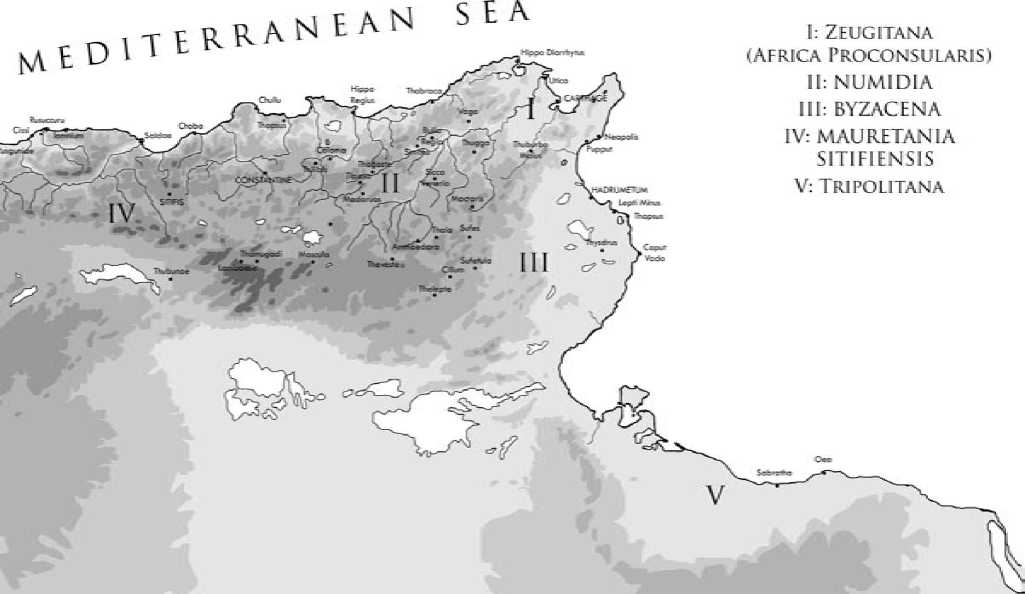The fifth century was a period of chaos within the Mediterranean world. As the political authority of the western Roman empire crumbled, powerful new groups rose to prominence in the provinces.1 Among the most important were the Vandals. Under Geiseric, their most famous king, they invaded the rich Roman provinces of North Africa and captured the grand commercial city of Carthage in ad 439. For the next century, the Vandals prospered at the very heart of the dying empire. In ad 455, Geiseric unleashed a cataclysmic sack of the City of Rome, and Vandal piracy remained a constant plague on Mediterranean shipping for decades thereafter. Within North Africa itself, the century of Vandal rule was a period of extremes. Remembered by many for their heretical beliefs, and their vicious persecution of orthodox ‘Nicene’ Christians, the Vandals were also sensitive patrons of learning. Grand building projects continued, schools flourished and North Africa fostered many of the most innovative writers and natural scientists of the late Latin West.
The successes of the Vandals were intimately bound up in the prosperous kingdom which they inherited. At the height of the Roman period, North Africa had been a jewel in the imperial crown.2 The wealth of the African cities, the rich grain fields of Zeugitana and Numidia, and the extensive olive groves of Byzacena and the Mauretanias had become almost proverbial by the early fifth century. An anonymous merchant of the fourth century described Africa as ‘exceptional and admirable’; to Martianus Capella, a scholar of the fifth century, it was ‘awesome in its prosperity’.3 For two and a half centuries the African provinces had produced a massive agricultural surplus to be shipped to Rome as tax. Any grain, olive oil, wine and fish which were not appropriated by a hungry state had been sold, either within North Africa itself or in cities scattered around the Mediterranean. Not everyone in late Roman Africa was rich, but the region was certainly prosperous: its cities were ornamented with public buildings, baths, theatres and amphitheatres; olive oil burned
The Vandals Andy Merrills and Richard Miles © 2010 Andy Merrills and Richard Miles. ISBN: 978-1-405-16068-1

Figure 1.1 North Africa in the Vandal period
Prodigiously in lamps throughout the region and farms continued to flourish in the countryside. Culturally, too, Roman North Africa was unusually vibrant. Christianity had been brought to the region during the second century ad, and thereafter the faith flourished there with particular strength. The African Church was defined by its saints and martyrs, but was shaped by its great theologians: Tertullian was prominent in the second century, Cyprian and Arnobius in the third, and Lactantius in the fourth. This tradition reached its peak with Saint Augustine, who was educated in the Carthage of the late fourth century, provided leadership as the bishop of the city of Hippo Regius in the early fifth, and eventually died in ad 430, as the Vandals lay siege to his adopted home.
Yet the Vandal kingdom proved to be short-lived. In ad 534, a little less than a century after they occupied Carthage, the Vandals lost the city, this time to the resurgent eastern Roman Empire of Justinian and his general Belisarius. Less than two centuries after that, this restored imperial authority was itself swept away by the expansion of the Islamic powers from the east. As a result, North Africa was dramatically severed from Europe, and a region which had once nestled at the very heart of the classical world was all but forgotten by the successor kingdoms of the west. The Vandals, too, drifted into obscurity. When the historians of these expanding Christian nations tried to make sense of the great decline of the Roman west, and developed heroic traditions around the Goths, Franks, Angles and Alemans, the Vandals were frequently cast aside as curious anomalies. With no historian to preserve ‘their’ side of the story, the Vandals were presented as cruel persecutors and violent savages, but also as once-proud barbarians who collapsed into moral degradation and lost themselves in the decadent excesses of the later Roman Empire, a pattern which dominated scholarship from the medieval period to the nineteenth century. Today, if the Vandals are remembered at all, it is through the negative associations of the term ‘vandalism’ - a censorious term for the wanton destruction of art and architecture that is shared by all of the major western European languages. Yet even here, the legacy of the group is uncertain. What was once a vivid metaphor for this destruction - Vandalism - has since lost its capital ‘V’, and with it its historical specificity. Even the popularity of this most chauvinistic of caricatures has not managed to save the Vandals from obscurity.
The present book is an attempt to re-assess the Vandals from the perspective of the twenty-first century. It adopts a critical new assessment of the textual sources available to us - these are many and varied, including the lives and writings of saints, formal histories, chronicles, letters, poems and estates records - and combines this with a detailed discussion of recent archaeological evidence. For the most part, then, it is a history of North Africa and the Mediterranean world in the fifth and sixth centuries ad. But the history of the Vandals did not simply end with the destruction of their kingdom. If the Vandals have slipped from the popular imagination in recent years, if images of fur-clad barbarians have been supplanted by graffiti artists or protesters as symbols of social instability, this in itself is an interesting legacy and deserves some attention.
This chapter will introduce the Vandals through the accounts of later writers - historians, novelists, playwrights and politicians, amongst others. These are arranged into three groups. The first considers the Romantic image of the Vandals, that is to say the more or less fictionalized use of the group within idealized accounts of prehistory or the medieval world. The second discusses the stereotype of the destructive Vandals, and the notion that the group was particularly violent, even by the standards of the time. The third examines the peculiar ‘pan-Germanic’ discourse which presented the Vandals as a specifically German people, and which sought to associate their portentous name with the ruling aristocracies of different Scandinavian and German territories in the early modern period. These sections are primarily concerned with later medieval and early modern accounts - down to the end of the eighteenth century. Although images of ‘Romantic’, ‘destructive’ and (especially) ‘Germanic’ Vandals continued to circulate in the nineteenth and twentieth centuries (and indeed remain in popular currency), important changes in the writing of history from the end of the eighteenth century transformed scholarship on the group. The final section of the introduction discusses the emergence of modern historiography on the Vandals down to the present day, and explains the ambitions for the current book within this context.




 World History
World History









